Half-track
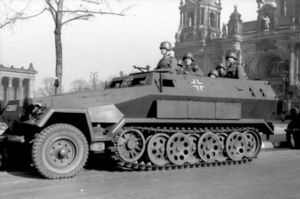
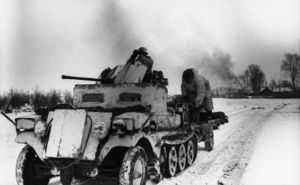
A half-track is a civilian or military vehicle with regular wheels on the front for steering, and caterpillar tracks on the back to propel the vehicle and carry most of the load. The purpose of this combination is to produce a vehicle with the cross-country capabilities of a tank and the handling of a wheeled vehicle. It is not difficult for someone who can drive a car to drive a half-track, which is a great advantage over fully-tracked vehicles. This facilitates moving personnel and equipment successfully across varying terrain.
The main advantage of half-tracks over wheeled vehicles is that the tracks reduce the vehicle's overall ground pressure and give it greater mobility over soft terrain like mud and snow, while they do not require the complex steering mechanisms of fully tracked vehicles, relying instead on their front wheels to direct the vehicle, augmented in some cases by track braking controlled by the steering wheel.
Contents |
History
Kégresse track
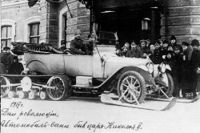
The French engineer Adolphe Kégresse converted a number of cars from the personal car park of the Tsar of Russia to half-tracks in 1911.
His system was named after him: the Kégresse track, which used a flexible belt rather than interlocking metal segments. He applied it to several cars in the Royal garage including Rolls-Royce cars and Packard trucks. The Russian army also fitted the system to a number of their Austin Armoured Cars. From 1916 onward there was a Russian project by the Putilov plant to produce military half-tracks (Austin-Putilov model) along the same lines using trucks and French track parts. After the Russian Revolution Kégresse returned to his native France where the system was used on Citroën cars between 1921 and 1937 for off-road and military vehicles.
Steam Log Hauler


The concept originated with the hauling of logs in the northeastern U.S., with the Lombard Steam Log Hauler built by Alvin Lombard of Waterville, Maine from 1899 through 1917. The vehicle resembled a railroad steam locomotive, with sled steerage (or wheels) in front and crawlers driven by chains instead of the driver wheels of a locomotive.[1]
By 1916, dog and pony show operator H.H. Linn abandoned his gas and steam powered four and six wheel drive creations and had Lombard build a motor home/traction engine run by an underslung four cylinder gasoline engine to travel the unimproved roads of the day, wheels in front, tracks in rear - the first payload-carrying halftrack. By 1917, this was replaced by a smaller machine with two wheels in front and a single track in rear because rural wooden bridges presented problems.
Stability issues, coupled with a dispute between Linn and Lombard, resulted in Linn creating Linn Manufacturing Company, builder of the Linn tractor, for building and putting his own improved civilian halftrack-style machines on the market, Lombard attempted to follow, but for the most part, remained a pulling machine. Linn would later register "HAFTRAK" and "CATRUK" as trademarks, the latter for a halftrack meant to convert hydraulically from truck to crawler configuration.
In the early days of bulldozers, Holt tractors had tricycle steering, owing to engineering difficulties with the caterpillars. The company's initial products focused on agricultural machinery and were distributed internationally. During World War I, its production capacity became focused on military needs. Its tractors replaced horses and were widely used by the Allies as artillery tractors and for hauling supplies. The Holt tractors went on to become the basis for the Mark I tanks, the Schneider CA1 tank, and the German A7V tank. The Holt would be renamed the Caterpillar 60, after merging with C.L.Best Company of California, in 1925, the Holt Manufacturing Company went on to form the company that would become known as Caterpillar.
Also of note are the "snowmobile" attachments for automobiles built by White Motor Company, Snowbird and others, for converting Fords to halftrack configuration, which could use skis instead of wheels in front for steering.
World War I
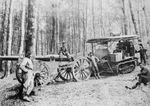
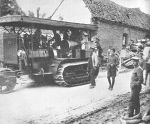
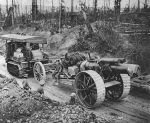
Tractor's, used to tow artillery and designs with front wheels and tracks in back began to appear prior to the outbreak of World War I, often based on agricultural machines such as the Holt tractor. The basic half-track concept was originally showcased by the British in World War 1.
With such tractors, it allowed the tactical use of heavier guns to supplement the light horse drawn field guns. For example in the British Army it allowed the heavy guns of the Royal Garrison Artillery to be used flexibly on the battlefield. In England, starting in 1911, David Roberts of Richard Hornsby & Sons had attempted to interest British military officials in a tracked vehicle, but failed.
Holt bought the patents related to the "chain track" track-type tractor from Richard Hornsby & Sons in 1914[2] for £4,000. Unlike the Holt tractor which had a steerable tiller wheel in front of the tracks, the Hornsby crawler was steered by controlling power to each track.[3]
When World War I broke out, with the problem of trench warfare and the difficulty of transporting supplies to the front, the pulling power of crawling-type tractors drew the attention of the military.
With tanks coming into the scene, however, the combination of tracks an wheels seemed impractical when fully-tracked or six-wheel, four-wheel drive vehicles were available. The half-track saw a come back in the 1930's with development occurring in several countries that would use them in World War II. The White Motor Company which had designed armored cars for the United States Army and United States Marines, continued after the First World War to develop armored cars and added tracks for the M2 Half Track Car and M3 Half-track.
Post World War I Tracks
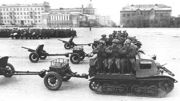
The T-20 armored tractor Komsomolets (Russian: Bronirovannyy gusenichnyy tyagach Komsomolets T-20, armored caterpillar-track tractor T-20) was designed in 1936 in Russia and were manufactured during 1937-1941.
The tractor was designed to tow light artillery pieces such as the 45mm anti-tank gun and the 120mm heavy mortar. The tractor could tow the weapons themselves plus a small quantity of ammunition, usually towed in a limber, along with up to six crewmen.
Autochenille & Autoneige
There were many civilian half-track experiments in the 1920s and 1930s. The Citroën company sponsored several scientific expeditions crossing deserts in North Africa and Central Asia, using their autochenilles. After War World I, the U.S. military wanted to develop a semi-tracked personnel carrier vehicle so looked at these civilian half-tracks. In the late 1920s the U.S. Army purchased several Citroën-Kégresse vehicles for evaluation followed by a licence to produce them. This resulted in the Army Ordnance Department building a prototype in 1939. In September 1940 it went into production with the military M2 and M3 half-track versions.
.jpg)
With the snow and ice of Canada in mind Joseph-Armand Bombardier developed 7 and 12 passenger half-track autoneiges in the 1930s, starting what would become the Bombardier industrial conglomerate. The Bombardier half-tracks had tracks for propulsion in the rear and skis for steering in front. The skis could be replaced by wheels in the summer, but this was uncommon.
WWII half-track
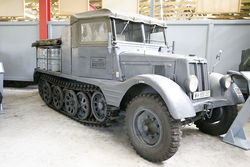
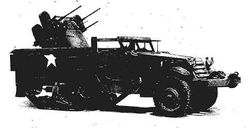
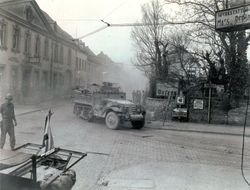
Half-tracks were used extensively in World War II, especially by the Germans with their SdKfz 11s, SdKfz 250s, and SdKfz 251s, and by the Americans with their M2s and M3s. Half-tracks were widely used as armored personnel carriers, but also saw duty as mortar carriers, self-propelled anti-aircraft guns, self-propelled anti-tank guns, artillery tractors, armored fighting vehicles and in other tasks. In America, 43,000 Half-Tracks were produced by three primary manufacturers: Autocar Company Diamond T Motor Car Co. White Motor Company
Of these by far the largest manufacturer was White Motor Company with a total of 15,414 accepted by War Department. The other manufactures, Auto Car made 12,168 and Diamond T with 12,421.
The Germans used a small 2 seater half-track (sometimes incorrectly referred to as a "half-track motorcycle") called the Kettenkrad to pull small artillery guns, and for ammunition haulage and general transport. Although not a feature on American vehicles, steering can be assisted by track braking, controlled by the steering wheel.
Half-tracks soon fell out of favor, to be replaced by fully-tracked or fully-wheeled vehicles.
Half-tracks were used by France after World War II, seeing combat in the First Indochina War and the Algeria War. Half-tracks were in use by the Israeli Army until recently, where they were deemed to outperform fully-tracked and fully-wheeled vehicles for non-combat payload tasks such as carrying telecommunication equipment. As of March 2008, 600 halftracks were still officially listed in active duty, although they may have been phased out.[4]
Civil
|
Halftrack in use in Norfolk, UK, 1993. |
Popular culture
In the 1990 American animated film The Rescuers Down Under, produced by Walt Disney Feature Animation, the main antagonist Percival C. McLeach, an evil poacher, uses a Half-track to transport Cody and Marachute to Crocodile Falls.
See also
- Armoured warfare
- Kettenkrad - German half-tracked motorcycle used in WWII .
- HTMV - Indian half-track vehicle developed by Drdo
Notes and references
- ↑ Lore A Rogers and Caleb W Scribner. "Lombard Steam Log Hauler" (pdf). American Society of Mechanical Engineers. http://files.asme.org/ASMEORG/Communities/History/Landmarks/5587.pdf. Retrieved 6 January 2009.
- ↑ Hoffman, George (2007-02-21). "Hornsby Steam Crawler". British Columbia. http://hornsbycrawler.org/.
- ↑ Bellis, Mary. "History of Bulldozers". About.com. http://inventors.about.com/od/bstartinventions/a/bulldozer.htm. Retrieved 2010-02-28.
- ↑ "Israel Armed Forces" (pdf). http://www.inss.org.il/upload/(FILE)1206270841.pdf. Retrieved 2 June 2009.